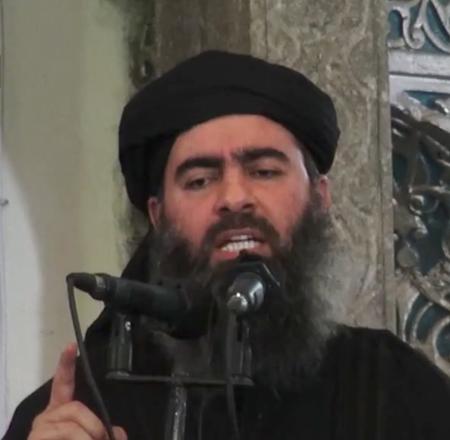You are here
Abu Bakr Al Baghdadi, the jihadist ‘caliph’
By AFP - Jul 06,2014 - Last updated at Jul 06,2014

BAGHDAD — Abu Bakr Al Baghdadi, the enigmatic self-proclaimed “caliph” of a state straddling Iraq and Syria, is increasingly seen as more powerful than Al Qaeda’s chief.
The leader of the powerful Islamic State (IS) militant group was on June 29 declared “caliph” in an attempt to revive a system of rule that ended nearly 100 years ago with the fall of the Ottoman Empire.
In a video posted online on Saturday, purportedly the first known footage of Baghdadi, he ordered Muslims to obey him during a Ramadan sermon delivered at a mosque in the northern militant held Iraqi city of Mosul.
“I am the wali [leader] who presides over you, though I am not the best of you, so if you see that I am right, assist me,” he said, wearing a black turban and robe.
“If you see that I am wrong, advise me and put me on the right track, and obey me as long as I obey God.”
The man now touted as the world’s most prominent jihadist, who has rarely been seen in public, appeared in Saturday’s video sporting a long beard, bushier and greyer than in the few previously released images.
His appearance follows the June 29 declaration by IS spokesman Abu Mohammad Al Adnani of a pan-Islamic “caliphate” with Baghdadi as its leader.
Baghdadi, born in Samarra in 1971 according to Washington, apparently joined the insurgency that erupted shortly after the 2003 US-led invasion of Iraq, at one point spending time in an American military prison in the country.
In October 2005, American forces said they believed they had killed “Abu Dua”, one of Baghdadi’s known aliases, in a strike on the Iraq-Syria border.
$10-million bounty
But that appears to have been incorrect, as he took the reins of what was then known as the Islamic State of Iraq (ISI) in May 2010 after two of its chiefs were killed in a US-Iraqi raid.
Since then, details about him have slowly trickled out.
In October 2011, the US treasury designated him as a “terrorist”, and there is now a $10-million (7.3-million-euro) bounty for his capture.
This year, Iraq released a picture they said was of Baghdadi, the first from an official source, depicting a balding, bearded man in a suit and tie.
US officials said last year that the jihadist was probably in Syria, but information about his whereabouts since has been unclear.
If authenticated, Saturday’s video would indicate growing confidence of the once secretive Baghdadi, one of the world’s most wanted militants.
His appearance at the Mosul minbar, or pulpit, in the typical garb of a Sunni Muslim scholar, could also signal a shift from the battlefield to a more spiritual role for the self-proclaimed “caliph”.
Baghdadi, whose group advocates an extreme form of Islamic law and a return to the lifestyle of the first Muslims, pulled out a “miswak” — a twig used as a traditional toothbrush and reportedly used by the Prophet Mohammad — and cleaned his teeth before beginning his sermon.
He is touted within IS as a battlefield commander and tactician, a crucial distinction compared with Al Qaeda chief Ayman Al Zawahiri, and has attracted legions of foreign fighters, with estimates in the thousands.
At the time Baghdadi took over the group in April 2010, when it was ISI and tied to Al Qaeda, it appeared to be on the ropes after the “surge” of US forces combined with the shifting allegiances of Sunni tribesmen to deal him a blow.
But the group bounced back, expanding into Syria in 2013.
Baghdadi sought to merge with Al Qaeda’s Syrian franchise, Al Nusra Front, which rejected the deal, and the two groups have mostly operated separately since.
Related Articles
Abu Bakr Al Baghdadi, the self-proclaimed “caliph” terrorising Iraq and Syria, is a preacher who rose from obscurity to lead the world’s most feared jihadist organisation.
A new armed group calling itself the Caliphate Soldiers in Algeria has split from Al Qaeda’s North African branch and sworn loyalty to the radical breakaway group Islamic State (IS) fighting in Syria and Iraq.
Lebanese authorities are holding a daughter and an ex-wife of the head of the Islamic State (IS) jihadist group, Abu Bakr Al Baghdadi, the interior minister said.















